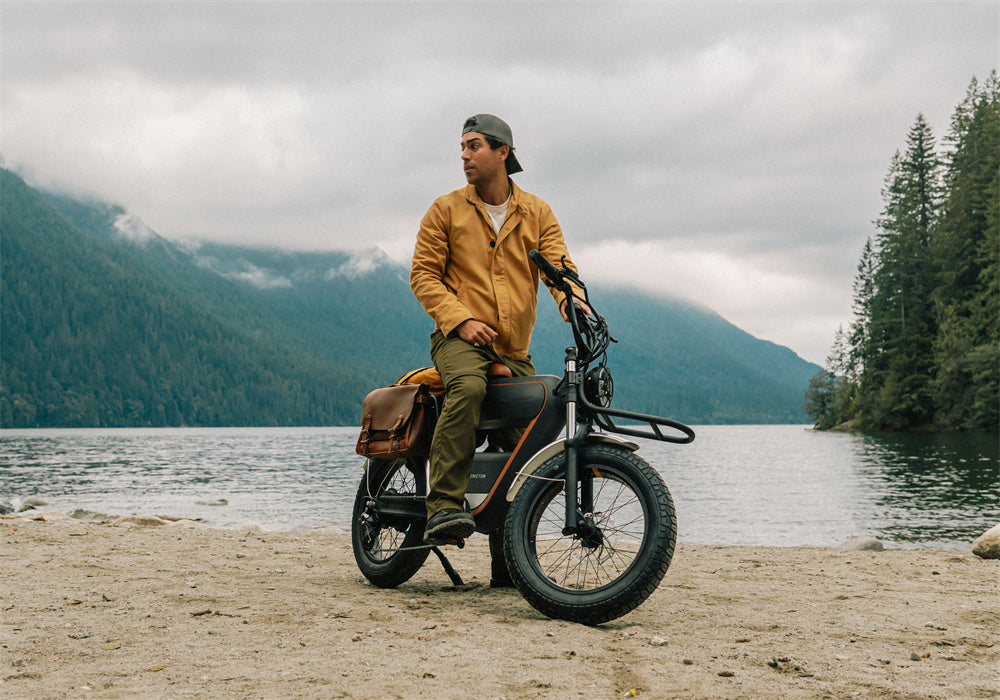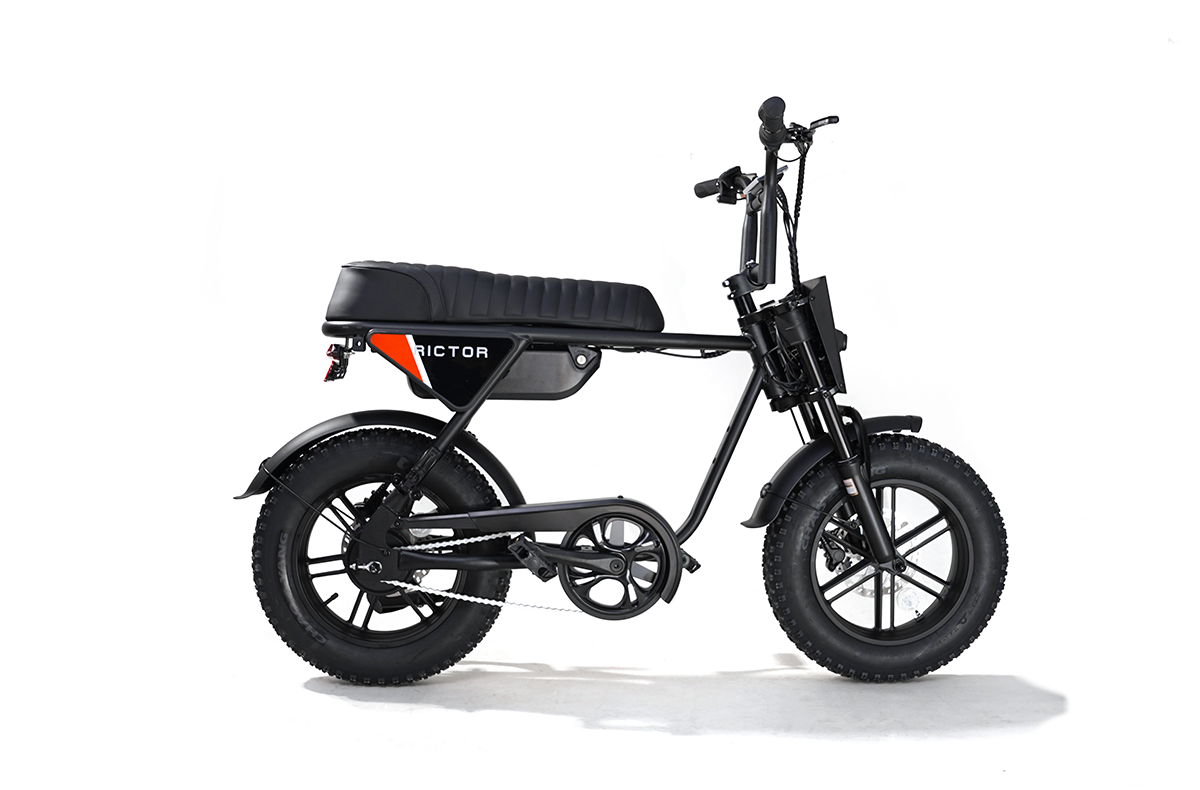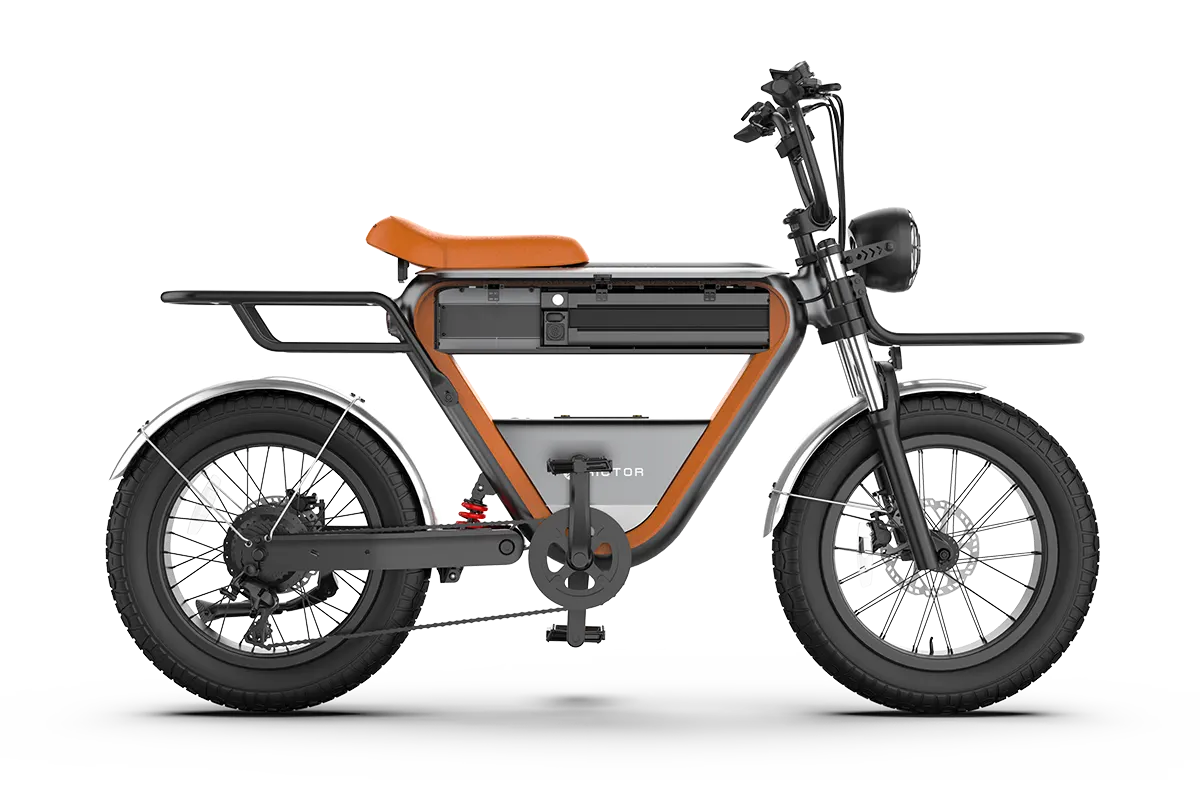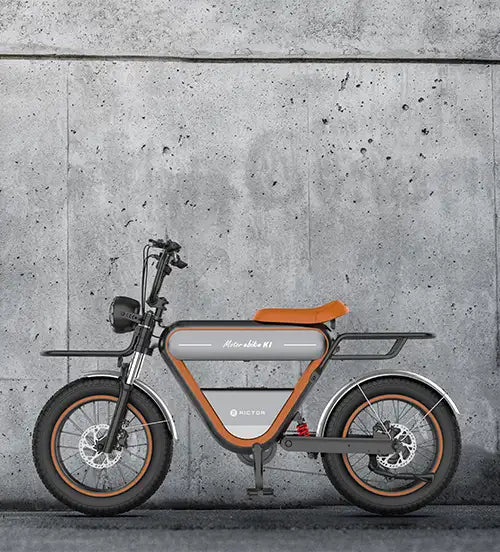
Comprehensive Bike Guide | Which Best Bike for Uphill
Still unsure which bike is best for uphill rides?
Want to easily conquer rough terrains? This guide covers all the different bike types, helping you find the perfect ride for tackling those challenging inclines.
What Type of Bike is Best for Climbing Hills
1. Mountain Bikes
Mountain bikes are designed for rugged trails and rough terrain, making them ideal for both uphill and downhill rides.
Hardtail Mountain Bikes
A hardtail mountain bike is one of the most efficient bikes for uphill riding. It has suspension in the front fork but no rear suspension, making it lighter and more responsive on climbs.
With the power transfer focused on the wheels without the loss of energy through rear suspension, hardtails are perfect for climbing steep hills.
They also offer good control on smooth trails and moderate downhill rides.
However, on rough descents, the lack of rear suspension can make the ride less comfortable.
Full Suspension Mountain Bikes
If your rides involve significant downhill terrain or rough trails, a fullsuspension mountain bike is your best bet.
These bikes come with both front and rear suspension, allowing for greater comfort and control on bumpy, technical trails.
Their additional weight means that uphill riding may require more effort. Fullsuspension bikes excel on downhill rides but are less efficient when climbing steep inclines.
Cross Country (XC) Bikes
If you're after speed and efficiency for uphill climbs, a crosscountry bike is a great choice.
These bikes are built for fast climbs and long distances on smooth terrain, thanks to their lightweight frame and narrower tires.
While they aren’t designed for rugged, technical descents, they excel at climbing hills on dirt roads or wellmaintained trails.
Enduro Bikes
Designed for riders who need a balance between uphill and downhill performance, enduro bikes have a bit more suspension than XC bikes, providing extra stability on downhill trails.
While they are a little heavier, enduro bikes still perform well on uphill climbs, especially on technical terrain.
They're a solid choice for riders who want to enjoy both the ascent and the descent.
2. Electric Bikes
If you're looking for a boost on your uphill climbs, electric bikes (eBikes) are a game changer.
Equipped with an electric motor, these bikes offer pedal assistance, making even the steepest climbs more manageable.
There are different types of eBikes tailored to specific riding needs:
Electric Mountain Bikes
These bikes combine the ruggedness of a mountain bike with the added power of an electric motor.
The motor assists you while you climb, helping you conserve energy and making steep hills feel easier to conquer.
Whether you're riding on gravel, dirt, or technical trails, eMTBs are perfect for both uphill and downhill performance.
The motor allows for quicker ascents, while the suspension offers smooth control during downhill rides.
Commuter Electric Bikes
If you live in a city or urban area with hills, a commuter eBike is a great option. These bikes come with moderate motors that are perfect for climbing city hills and urban streets.
While not designed for rugged trails, they provide enough assistance to make hilly commutes feel like a breeze.
Fat Tire eBikes
For riders who want to tackle the most difficult terrain, including snow, sand, or mud, fat tire eBikes offer increased traction and stability.
These bikes are great for uphill rides in soft or loose conditions, but they are heavier, which can affect your overall speed on smooth terrain.
Nonetheless, the added power from the motor makes climbing in challenging conditions a lot easier.
3. Gravel Bikes
Gravel bikes are versatile machines that can handle a range of surfaces, from paved roads to gravel paths.
While they are not specialized for extreme downhill descents, gravel bikes are ideal for long uphill climbs on mixed terrain.
With a lightweight frame and wider tires than road bikes, gravel bikes offer a smooth and stable ride.
If your rides include both uphill and downhill sections on nontechnical trails, a gravel bike could be the best option for you.
4. Road Bikes
When it comes to climbing paved hills, road bikes are the best choice.
Designed for speed on smooth, paved surfaces, road bikes are incredibly lightweight and efficient.
Their narrow tires and aerodynamic design help you accelerate quickly, allowing for a fast climb even on steep mountain roads.
Road bikes are not designed for rough downhill trails. If you’re riding primarily on paved roads, a road bike is the most efficient option for uphill climbs.
5. Hybrid Bikes
Hybrid bikes combine the best features of road bikes and mountain bikes, making them great allaround options for casual riders.
They are not as specialized for steep climbs or technical descents, but they provide a comfortable ride for moderate uphill and downhill riding.
With wider tires and a comfortable geometry, hybrid bikes are perfect for those who want a reliable bike for city commuting or casual rides on gentle hills.
6. Fat Bikes
If you're planning to ride in extreme conditions, such as snow, sand, or loose gravel, fat bikes are a musthave.
These bikes feature oversized tires that offer increased traction on soft, uneven surfaces, making uphill riding in tough conditions much easier.
While fat bikes are not the fastest on paved roads, they provide excellent stability and control on challenging terrains, making them the goto choice for offroad climbs.
SEE ALSO Rictor K1 All-Terrain Electric Bike: Is it the Ultimate Off-Road Champion of 2024?
Which Bike Gear is Best for Uphill
The gearing system determines how efficiently you can pedal and how much effort it takes to move your bike uphill.
The best gear for climbing depends on several factors: the steepness of the hill, your riding style, and the type of terrain.
The key principle behind selecting the correct gear is understanding the balance between pedal cadence (how fast you pedal) and force applied.
In simple terms, when you ride uphill, you want to maintain a consistent cadence that allows you to pedal without getting too fatigued.
Lower gears (often referred to as lowrange gears) make pedaling easier by reducing the amount of force needed to turn the wheels, but they come at the cost of speed. On steeper inclines, using a low gear allows you to maintain a higher cadence, which means you don’t tire as quickly, making the climb more manageable.
For steep hills, you'll want to shift to a low gear—this is typically the smallest chainring at the front and a larger cog at the rear.
This creates a gear ratio that provides the most mechanical advantage. It allows you to push through tough inclines without overexerting yourself.
Mountain Bikes (2x or 3x Drivetrains)
Most mountain bikes come equipped with a 2x or 3x drivetrain (two or three chainrings in the front, and a wide range of cogs in the back).
These setups allow for very low gears that are ideal for climbing hills. The lower gears help you maintain a comfortable cadence while pedaling through steep sections of a trail or road.
The extra chainrings give you flexibility to adjust based on the terrain and incline, allowing for smoother transitions.
2x Drivetrain: This setup is often used for riders who don’t need extremely low gears for the steepest climbs but still want efficient gearing for uphill riding.
3x Drivetrain: This is better for technical trails or steep hill climbs, as it provides a wider range of gears, including ultralow ones for very steep inclines.
Electric Bikes
Many eBikes are equipped with middrive motors, which offer direct motor assistance to the bike’s drivetrain. This means that your bike can offer even more torque and power during uphill climbs. Middrive motors work seamlessly with the bike's gears, optimizing your ride by maintaining a higher cadence and allowing you to keep your pace even on steeper inclines. For eMTBs (electric mountain bikes), a wide gear range with low gears is essential, as you’ll rely on both the motor and gears to conquer challenging hills.
Road Bikes
Road bikes generally have a 2x or 3x front chainring with 1130 tooth cogs in the rear. These are optimized for paved road climbs, not offroad terrain.
Road bikes with compact gearing (a smaller front chainring and larger rear cogs) are ideal for climbing hills at speed, especially on long mountain passes or steep city roads.
Their gearing is less effective on rough or technical trails compared to mountain bikes.
Why Low Gears are Better for Uphill
The reason low gears are ideal for climbing is that they allow you to apply less force to the pedals while keeping a higher cadence (pedaling speed).
This means you're able to maintain a more sustainable effort over time, avoiding muscle fatigue and cramping.
Higher gears require more effort for each pedal stroke, which can tire you out faster when climbing.
As the incline gets steeper, using a higher gear forces you to push harder, which might be fine for short, mild inclines but will quickly lead to fatigue on longer, steeper hills.
This is why having access to a wide gear range—especially a low gear—is key when you're looking for an efficient way to climb.
Does Bike Weight Matter Uphill
Yes, bike weight plays a significant role in uphill performance. The weight of your bike directly influences how much effort is required to move it uphill, which affects both your speed and endurance.
When you're climbing a hill, gravity is your main obstacle. The heavier the bike, the harder your body has to work to overcome that force. In simpler terms, the heavier the bike, the more energy you need to generate to push it uphill.
Gravity and Weight: The heavier the bike, the more gravitational force acts on it, requiring you to apply more power to move it upwards. For example, a mountain bike with a heavy frame, large tires, and additional suspension components will require more effort to climb a steep hill than a road bike with a lighter frame and narrower tires. When you ride uphill, you're fighting against both the weight of the bike and the incline. So, less weight means less force needed to climb the same incline.
Energy Efficiency: Lighter bikes are more energyefficient, especially on long, sustained climbs. The less the bike weighs, the less effort it takes for you to accelerate or maintain speed when going uphill. On long climbs, every ounce of weight saved can make a noticeable difference in how much endurance you need to finish the ascent.
Impact on Speed: Heavier bikes generally slow you down when climbing. You’ll notice this when comparing a fullsuspension mountain bike (which is usually heavier) to a hardtail or a road bike. The added weight of a fullsuspension bike (due to its extra components, like the rear shock and suspension system) can make climbing feel more difficult. In contrast, lightweight road bikes or crosscountry bikes excel in speed and efficiency on uphill climbs due to their lighter frames and components.
Why Does Bike Weight Matter on Uphill Rides
On uphill climbs, your energy is mostly spent overcoming the gravitational force that pulls you down. The heavier the bike, the harder your body has to work to push it upward.
The weight of the bike impacts the powertoweight ratio, which essentially refers to how much power you can generate compared to the weight you're carrying.
The better your powertoweight ratio, the easier it is to climb at a steady pace.
Lighter bikes (especially with a lightweight frame material like carbon or aluminum) reduce the effort required to climb, especially on long or steep inclines.
Heavier bikes, such as fullsuspension mountain bikes, provide more comfort on downhill trails but tend to require more effort when climbing.
This is because the additional weight (from the suspension system, thicker tires, and robust frame) translates to more energy required to overcome gravity.
If you ride an electric bike, the motor provides assistance during the climb, helping counteract the effects of weight. That said, even eBikes are still affected by the weight of the bike, as a heavier bike means a more energydemanding ride even with motorized help.
Are Electric Bike Worthy? My Experience
I’m the kind of person who really doesn’t want to break a sweat just to get to work, and showing up to the office drenched?
Not happening. My daily commute is 7 kilometers, and about 3 of those kilometers are straightup steep hills.
And let’s be real, I’m no Pogacar—I’m not exactly a climbing pro. That’s why the Rictor K1 all terrain electric bike is my go-to. The motor helps me power up those tough hills, so I can make it to work without feeling like I’m dying halfway up.
The rearcentral shock absorber keeps the ride smooth, and the 20" x 4.0" tires make sure I stay comfy, no matter what the road throws at me.
Even when it’s dark, I feel safe thanks to the ambient lighting, and with the IPX65 waterproof protection, I’m good to go in any weather.
The dualcylinder hydraulic disc brakes give me solid stopping power, and the Shimano 7 speed gear shift makes it easy to adjust on the fly. Plus, the onebutton control makes starting my ride a total breeze.
The Rictor K1 is seriously the perfect bike for my daily commute.
FAQs
Can an electric bike handle uphill climbs?
Yes, electric bikes are specifically designed to assist with uphill climbs. The motor provides additional power to help you tackle steep inclines without overexerting yourself.
Is it easier to climb hills on a hardtail or full-suspension bike?
A hardtail bike is typically easier to climb hills with due to its lighter weight and more efficient power transfer. Full-suspension bikes, while great for downhill, tend to be heavier and may require more effort on uphill climbs.
How important is the bike’s weight when climbing hills?
The lighter the bike, the easier it is to climb hills. Lighter bikes, such as those made of aluminum or carbon, reduce the effort needed to pedal uphill, making them ideal for steep inclines.





